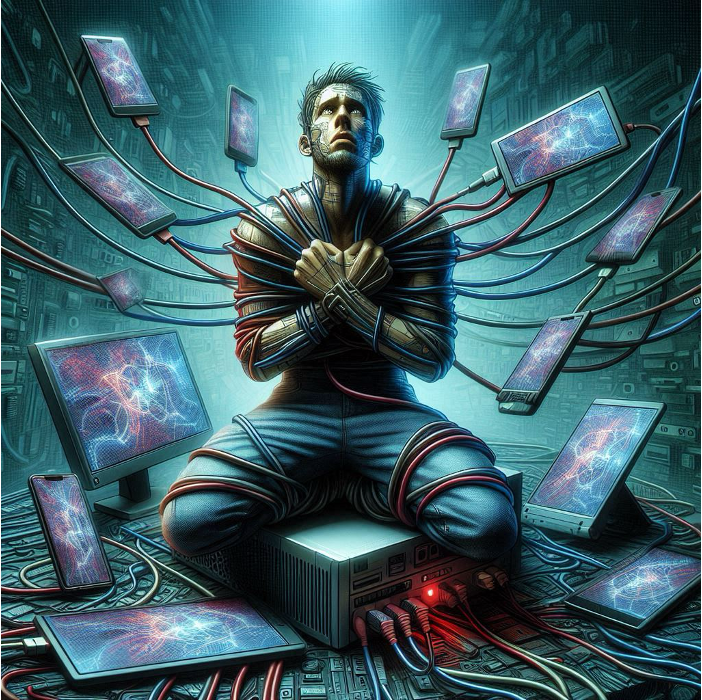
John: “Hi, my name is John and I am a Digitalholic”
People in the room: “Hi John”___________________________________________________________
- Do you feel anxious, restless, or irritable when disconnected from the internet or devices?
- Do you constantly check your devices even when it’s inappropriate?
- Do you use digital media to escape stress, loneliness, or boredom?
- Do you insist that screen time is “necessary” for work, socializing, or relaxation?
- Do you suffer from sleep issues, eye strain, anxiety, and social isolation?
If you answered yes to any (or all of the above) questions, you should realize that you are on the road to become a full-blown digitalholic, also known as a cyberholic. More specific terms include the following:
- Nomophobe – Fear of being without a mobile device or internet connection.
- Textaholic – Someone addicted to texting.
- Netaholic – Someone addicted to the internet.
- Infomanic – Someone obsessed with consuming and sharing information.
Digitalholicolism is similar to alcoholism in the sense that it involves compulsive behavior, dependence, and significant personal consequences, making recovery challenging without intervention. However, unlike alcohol, digital addiction is often socially accepted, making it harder to recognize as a problem.
Key symptoms of digitalholicalism
- Constantly Checking Devices – Frequent checking of emails, messages, or social media, even during conversations or work.
- Anxiety Without a Device – Feeling uneasy and irritable when disconnected from the internet or phone.
- Loss of Productivity – Difficulty focusing on tasks due to compulsive device use.
- Neglecting Responsibilities – Prioritizing online interactions over work, studies, or daily obligations.
- Sleep Disturbances – Staying up late due to screen time, leading to poor sleep quality.
- Social Withdrawal – Preferring online interactions over real-life connections.
The dangers of digital addiction
- Mental Health Issues – Increased risk of anxiety, depression, and stress.
- Physical Health Problems – Eye strain, headaches, poor posture, and sleep deprivation.
- Decreased Attention Span – Reduced ability to focus on complex tasks.
- Digital Burnout – Mental exhaustion from constant online engagement.
- Cybersecurity Risks – Over-sharing personal data, potentially leading to hacking or identity theft.
How can you cure digitalholicalism?
While there’s no one-size-fits-all cure, behavioral changes and self-discipline can significantly help. Possible treatments include:
- Digital Detox – Scheduled breaks from devices to reset habits.
- Screen Time Limits – Using apps to monitor and reduce usage.
- Mindfulness and Meditation – Practicing self-awareness to curb impulsive digital use.
- Setting Boundaries – No phone zones (e.g., during meals, before bed, or in meetings).
- Engaging in Offline Activities – Prioritizing hobbies, exercise, and real-world interactions.
How to prevent digital addiction
- Develop Healthy Digital Habits Early – Set boundaries from the start.
- Use Technology Intentionally – Avoid mindless scrolling.
- Limit notifications – It reinforces the habit of checking your phone constantly.
- Prioritize Face-to-Face Communication – Strengthen real-life relationships.
- Maintain Work-Life Balance – Separate work and personal device usage.
- Encourage Outdoor & Physical Activities – Reduce dependency on digital entertainment.
Conclusion
In a world where screens dominate our attention, the need for a support system like Digitalholics Anonymous feels more urgent than ever. Just as Alcoholics Anonymous provides a lifeline for those struggling with alcohol addiction, a similar framework could help individuals reclaim their time, relationships, and mental well-being from the grip of digital dependency. While technology itself isn’t the enemy, our unchecked reliance on it can be. The question is no longer whether digital addiction is real, it’s how we choose to address it. Perhaps it’s time to take the first step: acknowledging the problem and seeking balance in a hyperconnected world.


